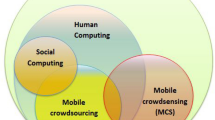Abstract
Mobile crowd sensing emerges as a new paradigm where widespread personal sensors can help to collect information beyond the previously possible scale. Existing spectrum sensing papers consider only secondary users in a cognitive system as the cooperative nodes. While if there are not enough secondary users exist, the cooperative detection performance will be degraded,and which will incur to a low spectrum efficiency or an inevitable interference to primary users. Hence in this paper, we take advantage of the Mobile Crowd Sensing to study the cooperative spectrum sensing where the sensing users are not only the secondary users but also a crowd of mobile users equipped with personal spectrum sensors (such as smartphones, vehicle sensors and tablets). Since spectrum sensing will incur costs for sensing users, an incentive mechanism is necessary to motivate adequate participation. In this paper, a Stackelberg game based incentive mechanism is proposed where the fusion center is leader and mobile sensing users are followers. In Leader game, the fusion center provides an optimal reward to incentive sensing users. And in Follower game, mobile sensing users adjust their own detection probabilities for obtaining more profits when given the reward published by the fusion center. Furthermore, the strategy adjusting process for each sensing user is modeled as a Coalition game where sensing users decide whether join in a coalition based on its utility maximization. We prove the existence of unique Nash Equilibrium in both Follower game and Leader game. Extensive simulations evaluate the feasibility and practically of proposed incentive mechanism. And the results show that a better detection performance can be obtained by the fusion center in our algorithm.










Similar content being viewed by others
References
Yucek, T., & Arslan, H. (2009). A survey of spectrum sensing algorithms for cognitive radio applications. IEEE Communications Surveys & Tutorials, 11(1), 116–130.
Chen, X., Chen, H.-H., & Meng, W. (2014). Cooperative communications for cognitive radio networks-from theory to applications. IEEE Communications Surveys & Tutorials, 16(3), 1180–1192.
Yang, G., W, Jun, Luo, J., Wen, O., Li, H., Li, Q., et al. (2016). Cooperative spectrum sensing in heterogeneous cognitive radio networks based on normalized energy detection. IEEE Transactions on Vehicular Technology, 65(3), 1452–1463.
Jiao, Y., Yin, P., & Joe, I. (2016). Clustering scheme for cooperative spectrum sensing in cognitive radio networks. IET Communications, 10(13), 1590–1595.
Aida Vosoughi, J. R., & Cavallaro, A. M. (2016). Trust-aware consensus-inspired distributed cooperative spectrum sensing for cognitive radio ad hoc networks. IEEE Transactions on Cognitive Communications and Networking, 2(1), 24–37.
Guo, B., Yu, Z., & Zhang, D. (2014). From participatory sensing to mobile crowd sensing. Proceedings of the IEEE PERCOM Workshops, 6(4), 593–598.
Gisdakis, S., Giannetsos, T., & Papadimitratos, P. (2016). security, privacy & incentive provision for mobile crowd sensing systems. IEEE Internet of Things Journal, 3(5), 839–853.
Pankratius, V., Lind, F., Coster, A., Erickson, P., & Semeter, J. (2014). Mobile crowd sensing in space weather monitoring: The mahali project. IEEE Communications Magazine, 52(8), 22–28.
Báguena, M., Calafate, C. T., Cano, J.-C., & Manzoni, P. (2015). An adaptive anycasting solution for crowd sensing in vehicular environments. IEEE Transactions on Industrial Electronics, 62(12), 7911–7919.
Chenren, X., Li, S., Zhang, Y., Miluzzo, E., & Chen, Y.-F. (2014). Crowdsensing the speaker count in the wild: implications and applications. IEEE Communications Magazine, 52(10), 92–99.
Jaimes, L. G., & Vergara-Laurens, I. J. (2015). A survey of incentive techniques for mobile crowd sensing. IEEE Internet of Things Journal, 2(5), 370–380.
Fan, Y., Sun, H., Zhu, Y., & Liu, X. (2015). Poster: Trim: A truthful incentive mechanism for dynamic and heterogeneous tasks in mobile crowdsensing. In International conference on mobile computing & networking (pp. 272–274).
Fan, Y., Sun, H., Zhu, Y., & Liu, X. (2015). Truthful incentive mechanisms for dynamic and heterogeneous tasks in mobile crowd sourcing. In IEEE 27 th international conference on tools with artificial intelligence (pp. 881–888).
Huang, K. L., Kanhere, S. S., & Hu, W. (2014). On the need for a reputation system in mobile phone based sensing. Ad Hoc Network, 12(1), 130–149.
Wen, Y., Shi, J., Zhang, Q., Tian, X., Huang, Z., Hui, Y., et al. (2015). Quality-driven auction-based incentive mechanism for mobile crowd sensing. IEEE Transactions on Vehicular Technology, 64(9), 4203–4215.
Qichao, X., Zhou, S., & Guo, S. (2015). A game theoretical incentive scheme for relay selection services in mobile social networks. IEEE Transactions on Vehicular Technology, 65(8), 6692–6702.
Liu, Y., Li, F., & Wang, Y. (2016). Incentives for delay-constrained data query and feedback in mobile opportunistic crowdsensing. Sensors, 16(7), 1138.
Ning, T., Liu, Y., Yang, Z., & Wu, H. (2017). Incentive mechanism for data dissemination in autonomous mobile social networks. IEEE Transactions on Mobile Computing, 16(11), 3084–3099.
Liu, Y., Xu, C., Zhan, Y., Liu, Z., Guan, J., & Zhang, H. (2017). Incentive mechanism for computation offloading using edge computing: A Stackelberg game approach. Computer Networks, 129, 399–409.
Zhang, W., & Letaief, K. B. (2008). Cooperative spectrum sensing with transmit and relay diversity in cognitive networks. IEEE Transaction on Wireless Communication, 7(12), 4761–4766.
Apt, K., & Witzel, A. (2006). A generic approach to coalition formation. Internet Workshop on Computational Social Choice(COMSOC), Amsterdam, the Netherlands.
Li, H., Cheng, X., Li, K., Xing, X., & Jing, T. (2013). Utility-based cooperative spectrum sensing scheduling in cognitive radio networks. In 2013 Proceedings IEEE INFOCOM (Vol. 12, No. 11, pp. 165–169).
Chen, L., Wang, J., & Li, S. (2008). Cooperative spectrum sensing with multi-bits local sensing decisions in congitive radio context. In IEEE wireless communication and networking conference 2008 (pp. 570–575).
Acknowledgements
This work is supported by National Natural Science Foundation of China (61571234, 61631020), National Basic Research Program of China (973 Program: 2013CB329005).
Author information
Authors and Affiliations
Corresponding author
Rights and permissions
About this article
Cite this article
Li, X., Zhu, Q. Game based incentive mechanism for cooperative spectrum sensing with mobile crowd sensors. Wireless Netw 25, 1855–1866 (2019). https://doi.org/10.1007/s11276-017-1637-4
Published:
Issue Date:
DOI: https://doi.org/10.1007/s11276-017-1637-4




